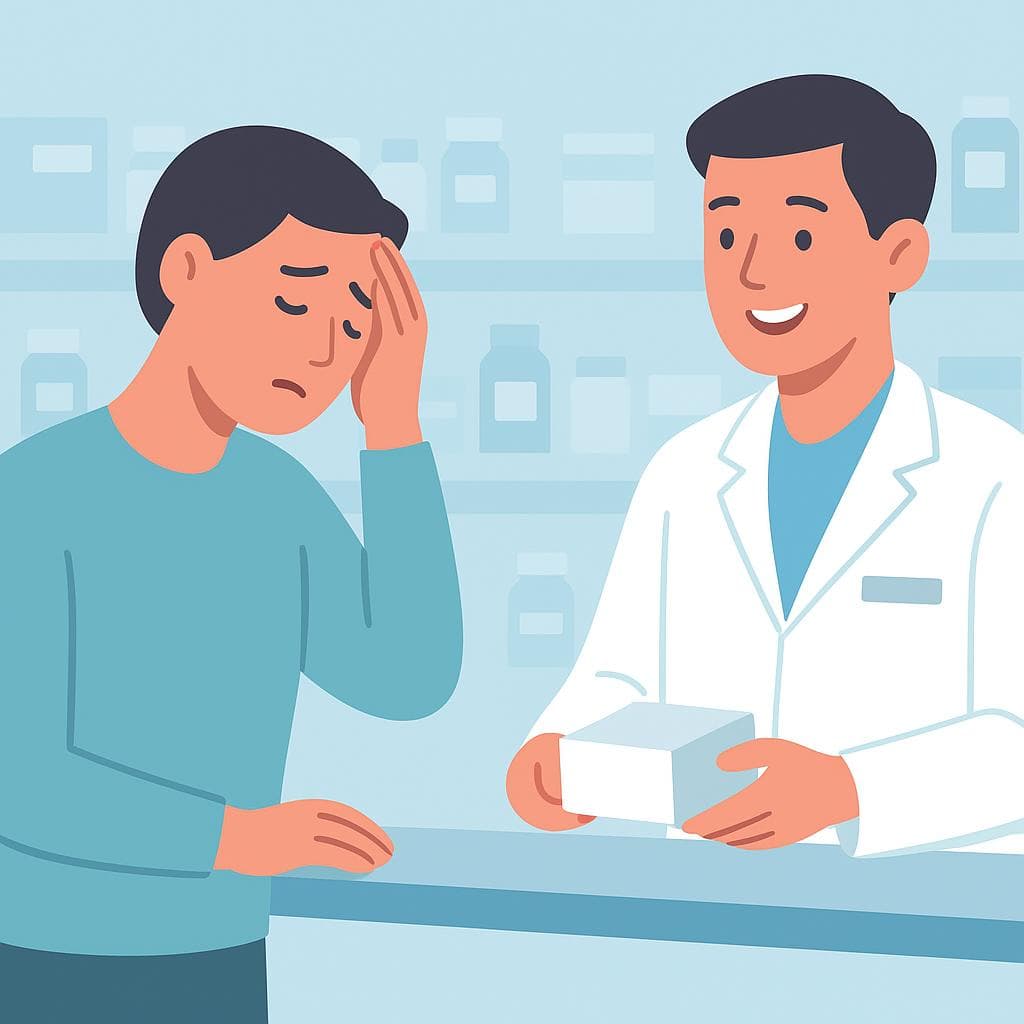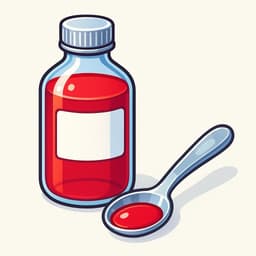I need medicine
in SpanishNecesito medicina
/neh-seh-SEE-toh meh-dee-SEE-nah/
The most direct and standard way to state that you require medication. It is understood everywhere, though native speakers often specify the type of medicine or the symptom.

When asking for medicine, it helps to gesture to where it hurts or describe the symptom.
💬Other Ways to Say It
Necesito un medicamento
/neh-seh-SEE-toh oon meh-dee-kah-MEN-toh/
Slightly more precise than 'medicina'. 'Medicamento' refers specifically to a pharmaceutical drug or medication.
Necesito algo para...
/neh-seh-SEE-toh AHL-goh PAH-rah.../
Means 'I need something for...' followed by the symptom (e.g., 'dolor' for pain). This is often more useful than asking for 'medicine' generally.
Necesito comprar unas pastillas
/neh-seh-SEE-toh kohm-PRAR OO-nahs pahs-TEE-yahs/
Means 'I need to buy some pills'. In Spanish, people often refer to medication simply as 'pastillas' (pills).
Necesito un remedio
/neh-seh-SEE-toh oon reh-MEH-dyoh/
In the Southern Cone, 'remedio' is the everyday word for medicine or medication.
Me urge conseguir medicina
/meh OOR-heh kohn-seh-GEER meh-dee-SEE-nah/
Means 'It is urgent for me to get medicine'.
¿Tiene algo para el dolor?
/TYEH-neh AHL-goh PAH-rah el doh-LOR/
Means 'Do you have something for the pain?'
🔑Key Words
Key Words to learn:
📊Quick Comparison
Choosing the right phrase depends on whether you know exactly what you want or if you need advice.
| Phrase | Formality | Best For | Avoid When |
|---|---|---|---|
| Necesito medicina | Neutral | General statements or emergencies | You need a specific item at the counter |
| Necesito algo para... | Neutral | Describing symptoms to a pharmacist | You have a specific prescription to fill |
| ¿Tiene [Nombre]? | Polite | Asking for a specific product | You don't know the local brand name |
📈Difficulty Level
The words are phonetic, but the 'c' in 'medicina' varies by region (s vs th sound).
Simple subject-verb-object structure.
Straightforward, but knowing to ask by symptom rather than brand is helpful.
Key Challenges:
- Remembering generic names (Paracetamol vs Tylenol)
- Pronouncing 'medicamento' smoothly
💡Examples in Action
Disculpe, necesito medicina para la tos.
Excuse me, I need cough medicine.
Me siento muy mal, necesito ir a comprar un medicamento.
I feel very bad, I need to go buy some medication.
¡Ayuda! Mi amigo es diabético y necesita su medicina urgente.
Help! My friend is diabetic and needs his medicine urgently.
¿Me podría dar algo para el dolor de estómago?
Could you give me something for a stomach ache?
🌍Cultural Context
Pharmacists are Advisors
In many Spanish-speaking countries, pharmacists play a much more active role than in the US or UK. It is very common to describe your symptoms directly to the pharmacist ('Tengo dolor de cabeza') rather than just asking for a specific brand. They will often diagnose minor ailments and recommend the best 'medicamento' for you.
Over-the-Counter vs. Prescription
Many medications that require a prescription in the US (like strong painkillers or certain allergy meds) might be available over the counter in countries like Mexico or Colombia. However, regulations on antibiotics have tightened significantly across Latin America and Spain, so you will almost always need a 'receta' (prescription) for those.
The Concept of 'Remedios'
While 'medicina' is universal, in the Southern Cone (Argentina, Uruguay), you will hear people say 'remedios' for pharmaceutical drugs. In other regions, 'remedio' might imply a home remedy (like herbal tea), so context matters!
❌ Common Pitfalls
The 'Drogas' Trap
Mistake: "Saying 'Necesito drogas' to mean 'I need drugs/medicine'."
Correction: Necesito medicina / Necesito un medicamento.
Expecting English Brand Names
Mistake: "Asking for Tylenol or Advil by name."
Correction: Asking for the active ingredient (Paracetamol, Ibuprofeno).
💡Pro Tips
Focus on the Symptom
If you forget the word for 'medicine', simply say 'Tengo...' (I have...) followed by your problem, like 'Tengo dolor' (I have pain) or 'Tengo fiebre' (I have a fever). The pharmacist will immediately understand you need medicine.
Look for the Green Cross
In Spain and many parts of Latin America, pharmacies are identified by a large, flashing green cross neon sign outside the shop. If you need medicine late at night, search for a 'Farmacia de Guardia' (on-duty pharmacy) or 'Farmacia 24 horas'.
🗺️Regional Variations
Spain
In Spain, pharmacies are very regulated. You often ask '¿Me das algo para...?' (Can you give me something for...?). The 'th' pronunciation is the main marker here.
Mexico
In Northern Mexico, you might hear 'Ocupo' instead of 'Necesito'. Generic medicines are often sold at 'Farmacias Similares' and are very popular.
Argentina / Southern Cone
The word 'remedio' is the standard for medicine you buy at the pharmacy. 'Medicina' sounds a bit more formal or abstract.
💬What Comes Next?
The pharmacist asks if you have a prescription
¿Tiene receta?
Do you have a prescription?
No, no tengo receta. / Sí, aquí está.
No, I don't have a prescription. / Yes, here it is.
Asking how often to take the medicine
Tome una cada ocho horas.
Take one every eight hours.
¿Con comida o sin comida?
With food or without food?
🔄How It Differs from English
English speakers often ask for medicine by brand name (Tylenol, Pepto-Bismol). In Spanish, it is much more common to ask by the active ingredient (Paracetamol) or by describing the symptom ('algo para el dolor'). Also, the false friend 'drogas' is a major pitfall.
False Friends & Common Confusions:
Why it's different: In English, 'drugstore' and 'drugs' can be neutral. In Spanish, 'drogas' usually implies illegal narcotics.
Use instead: Use 'medicina' or 'medicamentos'.
🎯Your Learning Path
➡️ Learn Next:
How to say I have a headache
You usually need to explain WHY you need medicine.
Where is the pharmacy?
You need to find the place to buy the medicine first.
How to say call an ambulance
Critical vocabulary if the situation is worse than just needing medicine.
✏️Test Your Knowledge
💡 Quick Quiz: I need medicine
Question 1 of 3
You are in a pharmacy in Mexico and have a headache. What is the BEST thing to say?
Frequently Asked Questions
Can I just say the brand name like Tylenol?
You can try, but it's risky. Brand names change between countries (e.g., Tylenol is not common in Spain; they use Gelocatil or just generic Paracetamol). It is much better to learn the generic name or the word for your symptom.
Is 'medicina' or 'medicamento' better?
Both are correct. 'Medicina' is broader and easier for beginners. 'Medicamento' sounds a bit more formal and specifically refers to the pharmaceutical product. If you're unsure, 'medicina' is perfectly fine.
Do I need a prescription for everything?
No. Painkillers, cough syrup, and stomach relief are usually 'venta libre' (over the counter). However, antibiotics almost always require a 'receta' (prescription) in Spain and most of Latin America.
How do I pronounce the 'c' in medicina?
In Latin America (Mexico, Colombia, etc.), pronounce it like an 's' (meh-dee-SEE-nah). In Spain, it is typically pronounced with a 'th' sound (meh-dee-THEE-nah). Use whichever version matches the region you are visiting.
📚Continue Learning Spanish Phrases
Explore More Phrases in These Categories
Find similar phrases to expand your Spanish vocabulary:
Want to Learn More Spanish Phrases?
Browse our complete collection of Spanish phrases organized by situation, from basic greetings to advanced conversations. Perfect for travelers, students, and anyone learning Spanish.
View All Spanish Phrases →

